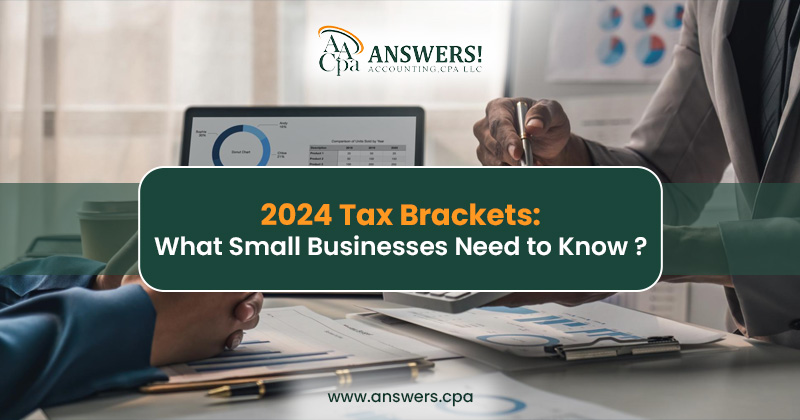Small Business Tax Brackets 2024: What You Need to Know
Staying up-to-date on tax brackets in 2024 is important for small business owners. Tax laws are constantly changing, and this can have a big impact on how much you owe. Knowing how these changes affect your business, whether you're a sole proprietor, LLC, or corporation, will help you make smart financial decisions.
We will explain the federal income tax brackets for 2024 and how they affect different business structures. We'll discuss significant changes in small business taxes, including tax credits and deduction updates. You'll also find strategies to minimize your taxes, whether you're a sole proprietor, a partner, or a married couple filing jointly. By the end, you'll have a better understanding of small business taxation and potentially lower your tax bill.
Tax Brackets in Colorado:
Colorado uses a graduated income tax system. This means that the more money you make, the higher the percentage of your income you pay in taxes. The state has different tax brackets, which are income ranges with specific tax rates. If your business earns more money, it falls into a higher tax bracket and pays a higher tax rate.
Understanding Small Business Tax Structures
When you start a small business, choosing the right tax structure is crucial. It can significantly impact your tax liability and financial management. Let's explore the main types of small business tax structures:
Pass-Through Entities
Pass-through entities are businesses where profits "pass-through" to the owners and are taxed at the individual level. This structure avoids double taxation, as the income is only taxed once on the owner's tax return. The most common types of pass-through entities include:
- 1. S Corporations: These entities pass corporate income, losses, deductions, and credits to their shareholders for federal tax purposes.
- 2. Limited Liability Companies (LLCs): LLCs are not subject to corporate income taxes. Instead, the owner(s) report the proceeds as federal income and are taxed at the individual rate.
- 3. Partnerships: Profits or losses flow through to the partners, who report their share on their tax returns.
- 4. Sole Proprietorships: As a single-owned business, you report proceeds as income on your tax return.
C Corporations
C Corporations are subject to double taxation. The business pays corporate tax on its earnings, and shareholders pay personal income tax on dividends. The federal corporate income tax rate is 21%. However, C-corps can deduct expenses to reduce taxable income.
Sole Proprietorships
As a sole proprietor, you report income and expenses on Schedule C of Form 1040. Your net income is taxable regardless of whether you withdraw cash from the business. For 2024, you pay self-employment tax at a 15.3% rate on net earnings up to $168,600, and Medicare tax at 2.9% on the excess.
Partnerships and LLCs
Partnerships and multi-member LLCs typically file Form 1065 but don't pay income tax directly. Instead, profits and losses pass through to the owners, who report their share on their tax returns. Single-member LLCs are usually treated as sole proprietorships for tax purposes.
2024 Federal Income Tax Brackets for Small Businesses
Understanding the 2024 federal income tax brackets is crucial for small business owners. Your tax rate depends on your business structure. For C Corporations, a flat corporate tax rate of 21% applies as of 2024. However, for pass-through entities like sole proprietorships, partnerships, and S corporations, the business income is taxed at the owner's tax rate, ranging from 10% to 37%.
Single Filer Brackets
For single filers, the 2024 tax brackets are as follows:
- • 10%: Up to $11,600
- • 12%: $11,601 - $47,150
- • 22%: $47,151 - $100,525
- • 24%: $101,526 - $191,950
- • 32%: $191,951 - $243,725
- • 35%: $243,726 - $609,350
- • 37%: More than $609,350
Married Filing Jointly Brackets
For married couples filing jointly, the 2024 tax brackets are:
- • 10%: Up to $23,200
- • 12%: $23,201 - $94,300
- • 22%: $94,301 - $201,050
- • 24%: $201,051 - $383,900
- • 32%: $383,901 - $487,450
- • 35%: $487,451 - $731,200
- • 37%: More than $731,200
Head of Household Brackets
For those filing as head of household, the 2024 tax brackets are:
- • 10%: Up to $16,550
- • 12%: $16,551 - $63,100
- • 22%: $63,101 - $100,500
- • 24%: $100,501 - $191,950
- • 32%: $191,951 - $243,700
- • 35%: $243,701 - $609,350
- • 37%: More than $609,350
It's important to note that these brackets are adjusted for inflation in 2024. Additionally, the standard deduction has increased to $14,600 for single filers and $29,200 for married couples filing jointly.
Read Blog- Tax Advisory Services Checklist for Businesses
Key Changes in Small Business Taxes for 2024
Standard Deduction Updates
As a small business owner, you'll be pleased to know that the standard deduction has increased for 2024. For married couples filing jointly, the standard deduction has risen to $29,200, an increase of $1,500 from 2023. If you're a single taxpayer, your standard deduction has increased to $14,600, up $750 from the previous year. Heads of households can now take a standard deduction of $21,900, which is $1,100 more than in 2023.
Qualified Business Income Deduction
The Qualified Business Income (QBI) deduction continues to be a valuable tax benefit for eligible self-employed individuals and small business owners. This deduction allows you to deduct up to 20% of your qualified business income. For 2024, the income thresholds have been adjusted. To qualify for the full deduction, your total taxable income must be under $191,950 for single filers or $383,900 for joint filers.
Corporate Tax Rate
For C Corporations, the federal corporate tax rate remains unchanged at 21% for 2024. However, it's important to note that state-level corporate tax rates vary. For instance, North Carolina has the lowest flat rate at 2.5%, while Minnesota has the highest top marginal rate at 9.8%. Some states have made changes to their corporate tax rates. For example, Nebraska has reduced its top marginal corporate income tax rate from 7.25% to 5.84%.
Strategies to Optimize Your Small Business Taxes
Maximizing Deductions
To reduce your tax liability, you need to make the most of available deductions. As a small business owner, you can deduct various expenses, including advertising costs, bank fees, business insurance premiums, and office supplies. If you work from home, you may be eligible for the home office deduction, which allows you to write off a portion of your housing expenses. You can also deduct travel expenses, such as lodging and transportation costs when traveling for business purposes.
Tax Credits for Small Businesses
Tax credits can significantly lower your tax bill. The Employee Retention Credit (ERC) is a valuable tax benefit extended by the American Rescue Plan. For 2021, eligible businesses can claim up to $7,000 per employee per quarter, with a maximum benefit of $28,000 for the full year. Additionally, the Paid Leave Credit allows businesses to take dollar-for-dollar tax credits equal to wages of up to $5,000 if they offer paid leave to employees who are sick or quarantining.
Read This- Benefits of Accounting Advisory
Quarterly Estimated Tax Payments
To avoid penalties and manage your cash flow effectively, it's crucial to pay quarterly estimated taxes. As a self-employed individual or small business owner, you need to pay both self-employment taxes (Social Security and Medicare) and income tax on your business profits. The due dates for 2024 quarterly estimated tax payments are April 15, June 17, September 16, and January 15, 2025. You can submit these payments online through the Electronic Federal Tax Payment System or use paper forms supplied by the IRS.
Conclusion
Navigating the world of small business taxes can be tricky, but understanding the 2024 tax brackets and recent changes has a big impact on your financial planning. By knowing how different business structures are taxed and taking advantage of deductions and credits, you can potentially lower your tax burden. This knowledge empowers you to make smarter decisions for your business's financial health.
To wrap up, staying on top of tax laws and using smart strategies to optimize your taxes is key for small business success. Whether you're a sole proprietor, part of an LLC, or running a corporation, being proactive about your taxes can lead to significant savings. Remember, while this info is helpful, it's always a good idea to chat with a tax pro to get personalized advice for your unique situation.
FAQs
1. How are tax brackets structured for the year 2024?
In 2024, there will be seven federal tax brackets: 10%, 12%, 22%, 24%, 32%, 35%, and 37%. The tax bracket you fall into depends on your taxable income and filing status. These brackets apply to the tax return you will file in 2025.
2. What is the minimum income a small business must earn to be liable for taxes?
Small businesses, including corporations and limited liability companies (LLCs) that choose to be taxed as corporations, do not have a minimum income threshold for taxation. Every dollar earned by the business, after accounting for deductions and credits, is subject to a corporate tax rate of 21%.
3. What are the federal tax rates applicable to small businesses?
The federal tax rate for small businesses varies depending on the structure of the business. Corporations are taxed at a flat rate of 21% on profits. Pass-through entities, such as sole proprietorships, partnerships, and S corporations, are taxed based on the owner’s personal income tax rates, which can range from 10% to 37%.
4. What will the self-employment tax rate be in 2024?
The self-employment tax rate for 2024 is set at 15.3% of net earnings. This rate encompasses Social Security and Medicare taxes for self-employed individuals.








